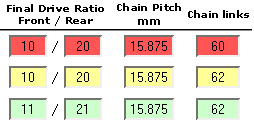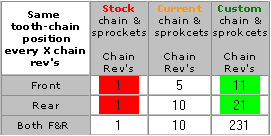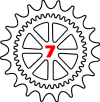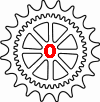|
Chain
(or belt) &
sprocket wear
influences: 'Same
tooth - same link' situation

'Same
tooth - same link' situation
This
happens when the number of links of the chain divided by the number of
teeth on a sprocket is a round number. Let's assume you have a chain
with 60 links, a front sprocket with 10 teeth and a rear sprocket with
20 teeth.
(F = 10, R =20 L = 60) Not a very realistic situation but easier for the
example.
The number
of Links divided by teeth on Front = L / F = 60 /10 = 6
This means that after six rotations of the front sprocket, the chain
made exactly 1 rotation and the first tooth on the front sprocket hits the
exact same link of the chain.
Same goes for the rear: L/R= 60/20=3. So every 3 rotations of the rear
sprocket, the chain made 1 complete rotation and the teeth are exactly
in the same position again.
So when this chain rotates once, both front and rear sprockets are in
the same position and hit the same link all the time.
This is not good.
It would
be better if the chain had un uneven number of links, say 61. Since this
is not very likely (chains almost always have an even number of links), lets take a
chain with 62 links. The calculation now are:
Front: L/F
= 62/10 = 6.2
Rear: L/R = 62/20 = 3.1
This means
that after 1 rotation of the chain, the front made 6.2 and the rear 3.1
rotations. This means other teeth hit the same link in the chain !
That is better !
Now how
long (how many rotations of the chain) does it take this time for the
teeth to hit the same link again? We then have to find the out how many
links will have to pass before the division results in an even number.
That is the case when we have the LCD of these numbers, the Least Common
Multiple. This can be calculated using the GCD, the Greatest Common
Denominator. The GCD for 62 and 10 is 2, that is the greatest number
both can be dived by which results in an even number.
Now the LCD = the multiple of 62 and 10 divided by the GCD: (62 *
10)/2 = 310.
this means after 310 links, the front sprocket is in the exact same
position again.
310 links means 310 / 62 = 5 rotations of the chain. So when
having a china with 62 links instead of 60 links, results in less wear
because now only every 5 rotations of the chain, the same tooth is hit.
So what
would be the optimum number of chain rotations then ? That would be when
we have a maximum number of links needed for the same position. So the
division LCD = (#1 * #2) / GCD should be maximum. That is the case when
GCD = 1 cause the result would then be (#1 * #2) / 1 = #1 * #2.
So when the GCD is 1 we reached our goal. This happens when one of the
number is uneven. Lets say we take an 11 sprocket instead of a 10
sprocket, Rear =20 and Links = 60. This results in a GCD of 1 and the
number of links needed is: (11 * 60) / 1 = 660 links. This means the
chain has to rotate 660/60 = 11 times before the same tooth hits
the same link again. This is the optimum !


So what
the relative chain wear indicator 'Same tooth - same link' table
does, is showing the number of chain rotations it takes with
selected number of teeth and links to hit the same tooth-link
combination and also marks them.
-
The
Worst is of course 1 rotation (background marked red)
when every rotation of the chain all teeth hit the same link all the
time.
-
The
Optimal combination (background marked green) is
when the chain has to rotate "the number of teeth on the sprocket"
to hit the same tooth again.
In
general, the more chain rotations it takes to hit the same tooth-link or
link-tooth combination, the better.
This way you can check if your chosen sprockets and chain are a better
or worse combination than to one you have or was stock. So it is
relative compared to the other combination, it is not an absolute indication
for chain wear.
Next:
Number of tooth-link contacts
Back to Gearing Commander main page |








